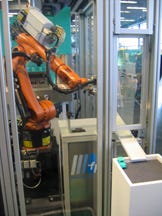Automation week helps break down ‘robot phobia’
“Program a 6-axis robot? That’s too complicated.” A program to help processors overcoming any lack of confidence with the proper use of robots and automation is underway this week at an open house in Lossburg, Germany, where injection molding machine manufacturer Arburg is giving processors hands-on automation experience, while also highlighting the ease of using the manufacturer’s Selogica control. The attendees also got to hear some "automation math" to highlight the speed with which automation can pay for itself.
December 16, 2009
“Program a 6-axis robot? That’s too complicated.” A program to help processors overcoming any lack of confidence with the proper use of robots and automation is underway this week at an open house in Lossburg, Germany, where injection molding machine manufacturer Arburg is giving processors hands-on automation experience, while also highlighting the ease of using the manufacturer’s Selogica control. The attendees also got to hear some "automation math" to highlight the speed with which automation can pay for itself.
|
It actually turned out to be quite easy get a robot to do your bidding with the control software, as even a trade journalist was taught in minutes how to program a linear robot to remove a part from a molding machine and drop it onto a conveyor (Ed. note: One good way to encourage employees is to place something tasty, such as cookies—wrapped, of course—in the molding machine and have them use the robot to retrieve those.) Operating the 6-axis Kuka robot was a bit more difficult, but clearly was a skill that can be learned in a short time (with perfection taking longer, of course). ‘Programming’ is the wrong term as Selogica, similar to control software available from some competitive manufacturers, includes a teach-in program with which the operator directs the robots movements, saves the various inflection points, and then lets the robot take care of the work.
The half-day event included three presentations plus time between those for hands-on training in small groups at a number of molding cells in the company’s customer center. About 380 processors from throughout Europe had registered for the automation forum, Arburg officials told MPW, which attended on TU with about 80 processors. During the hands-on portion of the event, it became quickly clear that some of the attendees—operators, mainly, with a sprinkling of more senior employees—were rather proficient, whereas many of the attendees—mostly management types—were showing their 'phobia' as they did their best to avoid being handed the robot's control. But the instructor ensured that all got their turn, and it quickly was clear that mistakes are not a problem as they can easily be rectified.
Rainer Stein, technical director for plastics processing at injection molder Gira (Radevormwald, Germany), encouraged processors in attendance to return to their shops and “tear down the hesitation to working with robots.” Stein’s presentation covered his company’s strategy for incorporating robots or any technology in a way that makes employees comfortable with it.
For example, he said, he and his colleagues were able to convince the company’s management early this year to acquire a 6-axis robot for a new job, even though it actually only required a 3-axis one. “So we bought the high tech but are using it at first on a simple project,” he explained, with that simpler project giving workers time to grow more comfortable with the robot and its capabilities. “This gets rid of the fear (of failure)—and then when we need the six axes, I can expect the employees’ top effort.” The company has applied the same logic to other purchases in the past, he said, purchasing top-end equipment before it was needed so that it was installed and ready, and employees were familiar with it, before it was actually needed.
“Training and practice—that’s the point,” emphasized Stein. Although the 6-axis robot took slightly longer to amortize, it also was efficient enough so that work on the project could be completed and there would remain about 800 hours of free robot time this year, time Gira used for training its employees. “Train your employees as if they were top-level athletes,” encouraged Stein.
A presentation from Arburg’s Christoph Hipp, part of the company’s automation/project department, highlighted the swift payback of investing in employees’ training with robots and their controls. Empowering employees with the knowledge to do the work on their own makes a processor more flexible to use it on new projects, to make changes to a current job, and to get robots in operation faster. “You recover the cost of the training in 1-2 changes (to the robot’s program),” he said.
In a concrete example, Hipp also showed how an investment in a robot could be recovered in a year or less even for projects in which the output does not run into the millions.
About the Author(s)
You May Also Like



